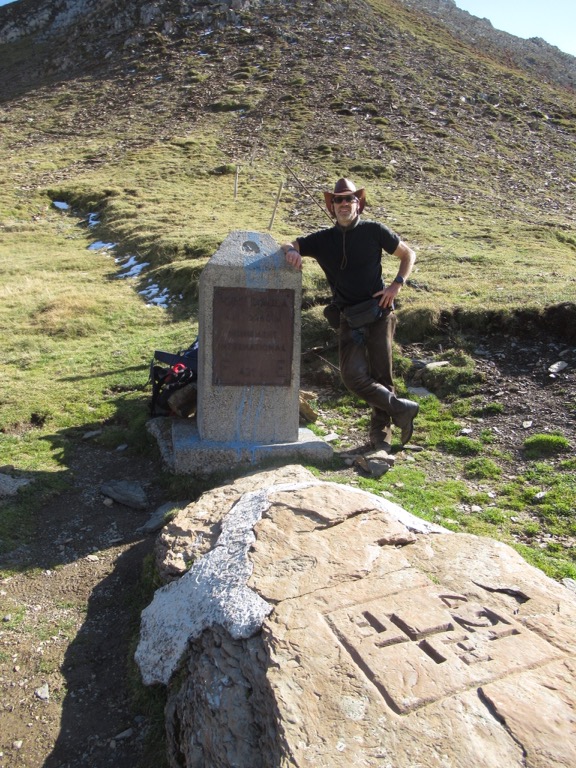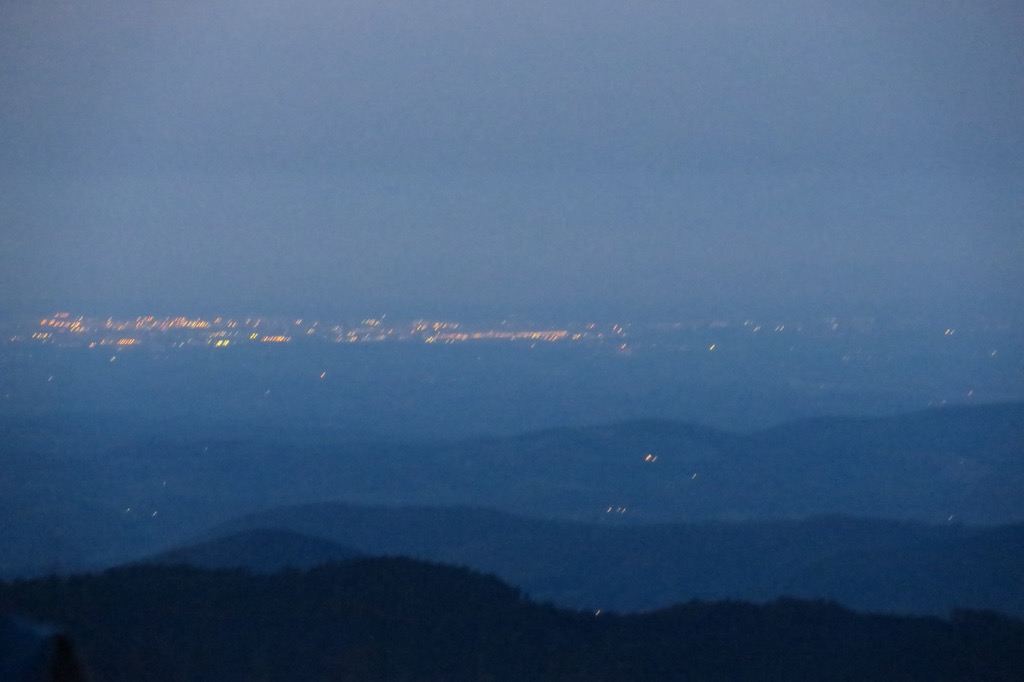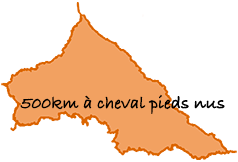 After a night in a comfortable bed in a warm chalet, the prospect of a damp morning is much less depressing and we set off in good spirits towards Vielha. However, it was not the weather but the state of the paths that dampened the spirits. Although we only climbed some 165 metres, it took over an hour to cover the 5 kilometres to the outskirts of Vielha where we met up again with our friends Sylvie and Philippe who showed us the best places in the town to restock and to stop for lunch.
After a night in a comfortable bed in a warm chalet, the prospect of a damp morning is much less depressing and we set off in good spirits towards Vielha. However, it was not the weather but the state of the paths that dampened the spirits. Although we only climbed some 165 metres, it took over an hour to cover the 5 kilometres to the outskirts of Vielha where we met up again with our friends Sylvie and Philippe who showed us the best places in the town to restock and to stop for lunch.
We continued up the Val d’Aran stopping that evening with a view over Vielha with the clouds clearing and the promise of better weather on the morrow.
 And indeed, the following morning dawned full of promise – so much so that it inspired a ‘home-made muesli’ breakfast made of rye bread that had not survived the journey, apple, some of the walnuts we had gathered on the fifth day, and honey.
And indeed, the following morning dawned full of promise – so much so that it inspired a ‘home-made muesli’ breakfast made of rye bread that had not survived the journey, apple, some of the walnuts we had gathered on the fifth day, and honey.
An absence of any decent path obliged us to keep to the road (happily not as busy as the main road through Vielha from France to the tunnel) from fairly early on in the morning. We passed through a couple of villages with incredibly pleasant architecture; although they were often no more than about thirty years old – or frequently less – the houses were all built in traditional style and in keeping with the original buildings. What a difference when we got to Baqueira (Vaquèira) – a ski-resort of brutal, unbridled 1970s architecture and a complete lack of any charm, warmth or welcome. However, on the road to Baqueira, we passed -going in the opposite direction- one Mercedes-Benz 220SL, one Triumph TR4 (not a TR4a), one Jaguar XK150 and no less than nine E-type Jaguars!
 As we just brushed the outskirts of this ugly town and started the climb towards Baqueira-Beret, we were passed by the first of what would turn out to be an enormous multitude of pick-ups, 4x4s and lorries toing and froing from a new construction site on one of the ski-pistes above Baqueira. On the ascent, a well grassed hairpin bend provided us with a good refuge for lunch, and what would appear to have been a very necessary rest for Fleur who fell asleep for a good twenty minutes.
As we just brushed the outskirts of this ugly town and started the climb towards Baqueira-Beret, we were passed by the first of what would turn out to be an enormous multitude of pick-ups, 4x4s and lorries toing and froing from a new construction site on one of the ski-pistes above Baqueira. On the ascent, a well grassed hairpin bend provided us with a good refuge for lunch, and what would appear to have been a very necessary rest for Fleur who fell asleep for a good twenty minutes.
 After lunch, we continued the climb -with steadily less traffic now- towards the Beret plain which forms the dividing point of the water table: one side is the arriu Garona (Garonne) descending into the Val d’Aran, the other is the arriu Noguera Pallaresa, each springing from an ‘Eye’ no more than 200 metres apart.
After lunch, we continued the climb -with steadily less traffic now- towards the Beret plain which forms the dividing point of the water table: one side is the arriu Garona (Garonne) descending into the Val d’Aran, the other is the arriu Noguera Pallaresa, each springing from an ‘Eye’ no more than 200 metres apart.
Although not exactly spectacular, at least these ‘eyes’ were clearly springs with a genuine stream of water.
 Studying the map showing the course of Garonne, we were surprised to note that about half the course actually lies in Spanish territory.
Studying the map showing the course of Garonne, we were surprised to note that about half the course actually lies in Spanish territory.
From here, we continued across the plain, following the course of the Noguera, now much pleasanter for the horses being a more lush grassy surface.  We passed a group of around 30 draught horses, one of which was a curious stallion: they came closer and followed us for a short way, but they quickly left us to continue without making any fuss. We passed cows and sheep and we were reassured to see that our mounts remained calm. That evening we camped at an altitude of 1732m (with no GSM network!) two kilometres from Montgarri, surrounded by the sounds of clanking cowbells and, in the distance , rutting stags.
We passed a group of around 30 draught horses, one of which was a curious stallion: they came closer and followed us for a short way, but they quickly left us to continue without making any fuss. We passed cows and sheep and we were reassured to see that our mounts remained calm. That evening we camped at an altitude of 1732m (with no GSM network!) two kilometres from Montgarri, surrounded by the sounds of clanking cowbells and, in the distance , rutting stags.
At the end of the day, the horses were in good condition, having not been ridden during the last few hundred metres of the days total climb of over 700m, and finishing on an more agreeable surface. Surprisingly, Vermeil and Fleur’s white hoofs (one each!) had changed colour becoming partially light. Walking on the tarmac appears to have dried and hardened the feet which now appear to be much less sensitive to gravel and stones this evening than they were this morning.
 The following morning, for the first time since setting out, everything was dry – not even a spot of dew! Just a thin layer of ice on the pools and small traces of hoar frost. And the sun, rising from behind the mountains, started to shine on us as we made to depart.
The following morning, for the first time since setting out, everything was dry – not even a spot of dew! Just a thin layer of ice on the pools and small traces of hoar frost. And the sun, rising from behind the mountains, started to shine on us as we made to depart.
Our route continued on the path to Montgarri, a chaming little church deep in the valley and a place of pilgrimage, regularly visited by herds of cows!  The path then passed though an ancient village of some fifteen houses, now all in ruin, and to Borda Perosa where, during lunch, the decision was made whether to cross back into France by way of the Port d’Aula or the Port de Salau. The latter would have given us a point of tourist interest with its ‘cathedral’ – the ruins of a transfer station with cable-car for transporting wood from Spain to France. The other apparent advantage of Salau was a climb of ‘just’ 600m compared with that of 800m for Aula. However, the descent on the other side would have been very steep and not at all comfortable for the horses whereas that from Aula was a true track. We chose for the comfort and security of our horses.
The path then passed though an ancient village of some fifteen houses, now all in ruin, and to Borda Perosa where, during lunch, the decision was made whether to cross back into France by way of the Port d’Aula or the Port de Salau. The latter would have given us a point of tourist interest with its ‘cathedral’ – the ruins of a transfer station with cable-car for transporting wood from Spain to France. The other apparent advantage of Salau was a climb of ‘just’ 600m compared with that of 800m for Aula. However, the descent on the other side would have been very steep and not at all comfortable for the horses whereas that from Aula was a true track. We chose for the comfort and security of our horses.
 Despite difficulties – once again – with the signing of the path and with the saddles sliding backwards due to the severity of the the climb, we made the ascent in just two hours. The views were magnificent with the autumnal colours starting to appear here and there. A herd of horses, just below the col, awaiting our passing, moved to a safe distance as we approached. We reached the col, with a few traces of snow in the shadows, at around 16:30 and we were back in France exactly two weeks after our departure from Fenouillet.
Despite difficulties – once again – with the signing of the path and with the saddles sliding backwards due to the severity of the the climb, we made the ascent in just two hours. The views were magnificent with the autumnal colours starting to appear here and there. A herd of horses, just below the col, awaiting our passing, moved to a safe distance as we approached. We reached the col, with a few traces of snow in the shadows, at around 16:30 and we were back in France exactly two weeks after our departure from Fenouillet.
As we had forecast, the descent was reasonably easy and we camped opposite the forestry hut at the lake the Étang d’Arreou, 1900m above sea level – and still without GSM network. Our camp gave us a splendid view over the Ariégeois mountains and, in the distance to the North, Saint Girons was well illuminated in the night.
In addition to the herd of horses, we has also encountered two marmots, one squirrel, several alpine choughs and a fox. And some bilberries that we rinsed off because of the fox…
That evening, we were suffering a water shortage (no springs nor clean water supplies during the previous 24 hours) and we were obliged to boil up water fetched from the lake.  However, the camping stove had already been giving us grief for a few days -the screw thread on the ring that attaches the burner to the bottle had stripped (after being used just 25 times!!!). Having miraculously got it to hold, one slight touch of the saucepan lid triggered a minor explosion of gas and a huge -readily fed- flame… Luckily, this was easily extinguished but a solution was needed. Otherwise, no water and no hot meal! With a small strip cut off the electric fencing and screwed between the screw and the ring on the burner, Tim managed to save the day…
However, the camping stove had already been giving us grief for a few days -the screw thread on the ring that attaches the burner to the bottle had stripped (after being used just 25 times!!!). Having miraculously got it to hold, one slight touch of the saucepan lid triggered a minor explosion of gas and a huge -readily fed- flame… Luckily, this was easily extinguished but a solution was needed. Otherwise, no water and no hot meal! With a small strip cut off the electric fencing and screwed between the screw and the ring on the burner, Tim managed to save the day…
 We were starting to get into the habit of sunny morning and dry starts!
We were starting to get into the habit of sunny morning and dry starts!  A major advantage being the time won breaking camp: rolling up mattresses and sleeping bags, coffee (for him) and tea (for her), preparing and eating two hazelnut and chocolate paste sarnies (Casino brand – like Nutella but without palm oil, a lot less expensive and just as tasty…), dismantling the electric fence, fetching the horses back after they had wandered off to find some more interesting grass to eat, filling the saddlebags and checking the balance of the pack-saddle (using an old wooden coathanger), fetching the horses back after they had wandered off to find some more interesting grass to eat yet again, saddling up the pack-horse, saddling up the mounted horses, mounting the packs on the pack-saddle, covering the pack with the tarpaulin, re-cinching (otherwise Fleur would have had the saddle under rather than on top of her…). And so we were ready for the off!
A major advantage being the time won breaking camp: rolling up mattresses and sleeping bags, coffee (for him) and tea (for her), preparing and eating two hazelnut and chocolate paste sarnies (Casino brand – like Nutella but without palm oil, a lot less expensive and just as tasty…), dismantling the electric fence, fetching the horses back after they had wandered off to find some more interesting grass to eat, filling the saddlebags and checking the balance of the pack-saddle (using an old wooden coathanger), fetching the horses back after they had wandered off to find some more interesting grass to eat yet again, saddling up the pack-horse, saddling up the mounted horses, mounting the packs on the pack-saddle, covering the pack with the tarpaulin, re-cinching (otherwise Fleur would have had the saddle under rather than on top of her…). And so we were ready for the off!
We continued our descent -on foot- to the Col de Pause. On the way we passed a Forestry Commission officer, a good number of fell-walkers, a lot of beautiful cows and their bulls, a small group of horses ans seven magnificent donkeys .
.
At Faup, still on foot, we stopped to replenish our water supplies at a spring and Nathalie even managed to telephone Amélie to wish her a happy 16th birthday.

After the stop, the descent continued yet further just until we reached Couflens – once renown for the world’s first tungsten mines. From then on, the going started to get tough again. The GR10, having passed through the garden of a kindly lady who opened the gated for us, climbs back up a valley, following a stream, initially as a very slippery path and then as an old paved track, parts of which were completely broken up. We tried to stop at a gîte halfway up the track but, even when Tim spoke to the owner in perfect Dutch, there was no room at the inn -not for the horses, at least. So the ascent continued, steadily steeper and steadily rockier -difficult even for the mountain walkers, let alone our horses (and us)- and we were obliged to dismount, the horses panting for breath and sweating cobs. We were but a third of the six hundred metres up the ascent…the rest was done with great effort, with stops every 50 metres. Until we finally reached the famous Col de la Serre du Cot (1546m).
 Two pleasant surprises awaited us: firstly a water trough for the horses and secondly a shepherd’s hut for us.
Two pleasant surprises awaited us: firstly a water trough for the horses and secondly a shepherd’s hut for us.

